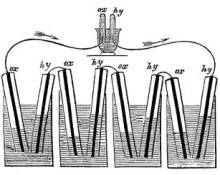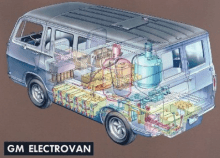While the name “energy server” might conjure up a high tech device unfathomable before this century, the newly unveiled Bloom Box is actually based on a much more staid concept: the fuel cell. While in recent years fuel cells have been all the rage due to their potential usage in everything from cars to laptops, their origins actually go back almost 200 years.
German scientist Christian Friedrich Schönbein first conceptualized the fuel cell in 1838, publishing an article about it in Philosophical Magazine in early 1839. Schönbein was more of what one would call “an idea person” as it was his friend, Welsh barrister Sir William Grove who first constructed what was then known as a “gas battery,” further refining the concept until he created an oxygen and hydrogen powered version in 1845.
Fuel cells, or electrochemical energy conversion devices, as they are known to people who like using big words, work in a surprisingly simple fashion. A modern fuel cell, as first refined by General Electric in the 1950s, can be thought of as a giant battery that, instead of storing all the chemicals inside, is constantly being replenished by an outside source.
Like a battery, the fuel cell has two sides, one positively charged and the other negatively. The power source (in recent years, usually hydrogen, but not necessarily so with the Bloom Box) is catalyzed into a gas form, where the positive and negative ions separate from one another. Those two separate ions are drawn to their respective ends of the fuel cell, but they have to go through a proton-exchange membrane, which acts like a maze, to get there. Running through this circuit is what generates the electricity, and at the end, the hydrogen is mixed with oxygen to create a very clean “waste product” — H2O / water.
 Part of the problem with fuel cells is that each cell only generates a tiny bit of electricity. To solve this, thousands of fuel cells are combined in each application, so as to generate enough power to be practical. This is why the first fuel cell vehicles, as seen in the 1970s, had to be vans, as the weight would be too much for a normal car.
Part of the problem with fuel cells is that each cell only generates a tiny bit of electricity. To solve this, thousands of fuel cells are combined in each application, so as to generate enough power to be practical. This is why the first fuel cell vehicles, as seen in the 1970s, had to be vans, as the weight would be too much for a normal car.
Even today, one of the biggest issues facing fuel cell automobiles is how to properly distribute all the extra weight so as not to deteriorate handling too much. Part of the genius of the Bloom Box system is that the “sheets” of pressed sand which power the device allow them to make each cell much smaller than previously possible. Furthermore, their system seems to have eliminated some of the expensive precious metals and composites, such as platinum, that have traditionally driven up the costs of manufacturing fuel cells.
Another seemingly revolutionary part of the Bloom Box energy distribution model is the concept of having power generated for a few hundred or thousand homes at each electrical substation, instead of being piped in for hundreds of miles over high tension power lines. This is another idea that, while seemingly novel, actually dates back about 100 years. Back when man-made electricity was still in its infancy, there were two competing standards for how to transmit that electricity: alternating current and direct current.
 Direct current, as championed by Thomas Edison, had one main advantage over alternating current — it was much safer. Just as squeezing two sides of a AA battery won’t shock you, if you stick a fork into a wall outlet powered by DC, you’d be similarly uninjured.
Direct current, as championed by Thomas Edison, had one main advantage over alternating current — it was much safer. Just as squeezing two sides of a AA battery won’t shock you, if you stick a fork into a wall outlet powered by DC, you’d be similarly uninjured.
The downside of DC was that it couldn’t be transmitted over long distances, so Edison envisioned small power plants on every few blocks, powering each neighborhood separately. People objected to the costs and blights associated with having so many power plants, and after a long, bizarre “war” involving electrocuted elephants and perhaps some actual scientific debate, Tesla and Westinghouse’s AC won out. Thus, localized power generation was kept in the dusty circular file of history — until today.
The Bloom Box looks like it has the potential to revolutionize how we make and distribute electricity. It is important, however, to remember that in the past few years, a number of other companies have come and gone, each with grand plans to reshape the electrical world. In 2007, Irish company Steorn generated considerable buzz with a device called the Orbo that could supposedly generate small amount of energy in perpetuity. After a series of embarrassing public failures, Steorn faded into obscurity.
While the Bloom Box does not violate the laws of physics, (yay!) it is important not to get too caught up in the hype. If this is a truly revolutionary device, the results will speak for themselves: Let’s hope they do.








Published: Feb 24, 2010 06:52 pm